M. T. Baltabaev, Sh. Abillayeva, A. Abilova
Nukus State Pedagogical Institute named after Ajiniyaz Nukus, Uzbekistan
Copyright © 2025 The Author(s). Published by Scientific & Academic Publishing.
This work is licensed under the Creative Commons Attribution International License (CC BY).
http://creativecommons.org/licenses/by/4.0/

Abstract
Licorice is one of the most important plants for the national economy. It is considered a wild plant with medicinal properties. The licorice root contains: glycyrrhizic acid and its potassium and calcium salts, 27 different flavonoids, sugar (glucose) up to 20%, 3% bitter substance, 20% starch, essential oil, dyes, vitamins, tannins, adhesive substances, organic acids, protein, and asparagine. The stem contains 11-18% protein, 10-15% proteins, 3.3-9.1% fat, and other beneficial compounds. Therefore, in the conditions of Karakalpakstan, it is important to study the bio-ecological characteristics of licorice and provide scientific information about its underground and aboveground organs. Licorice (Glycyrrhiza glabra L.) is a perennial herbaceous plant belonging to the genus Glycyrrhiza of the legume family Fabaceae (Leguminosae). Licorice is a polycarpic herbaceous plant, meaning it is a perennial wild plant that blooms and produces fruit and seeds every year. Due to its strong nectar secretion, it attracts honey bees and other insects. The above-ground part of licorice is used as nutritious fodder for animals. The licorice plant has a well-developed rhizomatous root system. The stem grows to a height of 150-160 cm, reaching up to 200 cm in some areas. The plant's underground rhizome (creeping root) grows horizontally, with new pods emerging every 25-50 cm along its length. The leaves are arranged alternately on the stem and are pinnately compound, consisting of 4-8 pairs of leaflets. The leaves are 11-18 cm long, with leaflets that are broadly elliptical in shape, have entire margins, and are slightly toothed at the base. They secrete a sticky substance. The pods formed on well-developed plants of couch grass are bare, flat, straight, and contain multiple seeds. Their length is 1-2.5 cm, with an average width of 0.5 cm. The seeds are kidney-shaped, darkish, light brown or light blue in color, measuring 2.0-2.6 mm in length and 1-2 mm in width. Some pods contain fully developed seeds. In our conditions, the licorice plant is found in its wild form. It is advisable to cultivate this plant, further improve its agrotechnical methods of propagation, and when creating its area, propagate it mainly in three ways: by seeds, rootstocks, and growing seedlings.
Keywords:
Root, Stem and vegetative propagation, Leaf, Stem, Root, Perennial herbaceous plant, Compound leaf, Rhizome, Lateral leaflet, Flower, Pod, Vegetative and generative organ, Bud growth point, Lateral branch, Underground and above-ground organs
Cite this paper: M. T. Baltabaev, Sh. Abillayeva, A. Abilova, Bio-Ecological Characteristics of the Licorice (Glycyrrhiza Glabra L.) Plant, International Journal of Genetic Engineering, Vol. 13 No. 6, 2025, pp. 106-110. doi: 10.5923/j.ijge.20251306.04.
1. Introduction
Licorice (Glycyrrhiza glabra L.) is a perennial herbaceous plant belonging to the legume family (Fabaceae) [3]. In his works, Theophrastus referred to this plant by the names of licorice root, Scythian grass, and Pontic grass. This plant is called "solodka golaya" in Russian, "shirinmiya," "chuchukmiya," "qizilmiya" in Uzbek, and "boyan" in Karakalpak. Licorice is a polycarpic herbaceous plant with well-developed stems and a cylindrical structure. The distribution area of licorice is very wide, found in the European part of the former Soviet Union, Crimea, the Caucasus, Siberia, Asia Minor, Iran, Afghanistan, and North Africa. In the territory of our republic, licorice is considered a typical forest plant and is mainly found in the lower reaches of the Syr Darya and Amu Darya rivers. A stalk. The above-ground part of a plant consists of vegetative and generative (bud, flower, and fruit) parts. The stem of the licorice is a well-developed herbaceous plant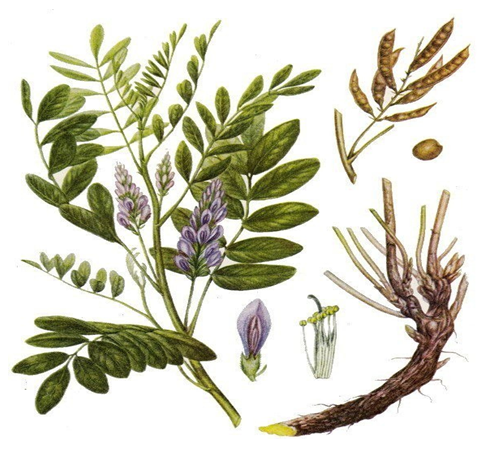 | Figure 1. General view of the licorice plant |
A plant with a cylindrical stem, up to 150-160 cm long, sometimes growing up to 200 cm. The plant's underground stem root (root) grows horizontally, and new pods grow from every 25-50 cm of its section (Figure 2). In fields sown with seeds, a large number of plants (stems) grow on the surface in the early spring.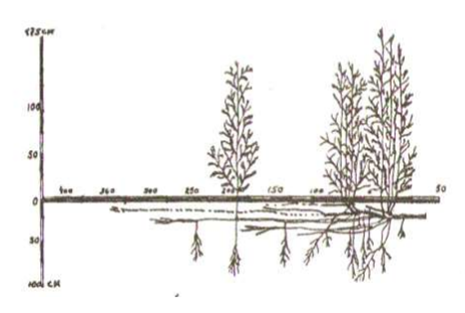 | Figure 2. Development of the above-ground part of the licorice |
Their growth rate will be high. Stem growth occurs due to budding at the growth point and stem elongation and thickening.Lateral branches appear in the leaf axils of the main stem; their number and development rate depend on the natural environment in which the plants are distributed. In natural conditions, the licorice plant grows and develops differently depending on soil fertility and its position in the phytocoenosis (Figure 3). | Figure 3. Growth and development of the above-ground and underground parts of the licorice plant |
The licorice plant propagates through its roots and rhizomes in its environment, spreading widely and forming licorice orchards. This property plays a significant role in the production and accumulation of root material (Figure 4).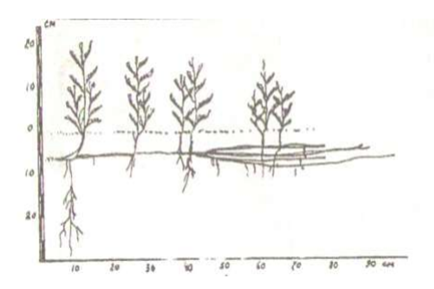 | Figure 4. Vegetative propagation of licorice |
Leaf. The leaves are sequentially arranged, compound, plucked feathery, with 4-8 pairs of leaflets. The leaves are 11-18 cm long, broadly elliptical, entire-edged, serrated, and produce sticky substances. The leaflet is 5 cm long and 2.5 cm wide. The leaf is a new compound small leaflet (parilistnik) (Figure 5). | Figure 5. Appearance of a licorice plant leaf |
The development of a plant's leaf depends on environmental factors. The number of leaves and their surface area are well-developed in phytocenoses along the banks of ditches and where dodder dominates. It is known that the productivity of photosynthesis in such places is high.The morphology and biology of the plant's flower are presented in the works of B.B. Kerbabayev (1954, T.P. Nadejdina, 1965) and other researchers. The flower is bisexual and cross-pollinated. The dust is coarse, moist, and heavy. It accumulates a large amount of honey and attracts bees. It is indicated that it blooms in April-May, and the waxy stalk ripens in July-September. There are two different opinions about the flowering period of a plant when sown from seeds.B. B. Kerbabayev (1954) and T. P. Nadejdina (1965) indicate that this plant blooms in the third year of its life in the Amudarya region. However, according to A. Bakhiev's research (1976), it blooms in the 4th year of its life, with only some individual plants developing a main stem. Several flowers are arranged on the flower spikes. The number of flower spikes and flowers on a plant depends on external environmental conditions. In plants with tall stems, the flower spikes are long and contain many flowers.According to A. Baxiyev's (1976) data, the length of flower stalks on the main stem of 80-cm tall plants does not exceed 10-12 cm and averages 33-35 flowers. At a height of 60 cm, the length of the flower stalks on the main stem will be 7-14 cm, and the number of flowers will be 26-38. The opening of flowers in the flower stalks of a plant is basipetal. An average of 2-5 flowers bloom on a single flower stalk every 24 hours. The bloomed flowers dry up and fall off after 2-3 days.According to T.P. Nadejdina's (1965) research, flowers bloom on a single flower stem within 1-2 weeks. Plants with a height of 100 cm and a number 10-12 flower stalks develop for 8-12 days. Plants with a height of 120-140 cm have 40-41 flower stalks, which bloom for 2-3 weeks.Long flower stalks with a large number of flowers develop in the middle part of the stem. The number of flower crowns is greater on lateral branches. It has been determined that the number of flower pots and flowers in dense bushes is lower compared to sparse areas.Studies have shown that the maximum number of flowers in a plant is found in Karaganov-Solodkovoy (1985 blossoms), Grebenshchikov -Solodkovoy (3279 flowers), and Panolistikov-Solodkovoy (4070 flowers) plant associations, while the minimum number of flowers is found in Vaynikov-Solodkovoy (342) and Kolosnikov-Solodkovoy (741) plant associations. Flower stalks develop from the stem and lateral branches of the licorice. (Figure 6)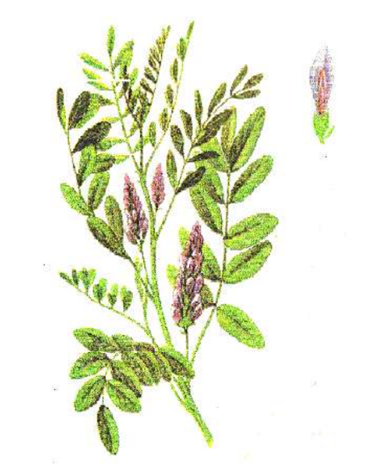 | Figure 6. Location of the flower stalk on the branches of the licorice |
The flowers are dark in color and are cross-pollinated. In each inflorescence, the flowers are arranged alternately on the flower buds (Figure 7). One of the characteristic features of the licorice plant is that not all flowers formed in the plant develop fruit, and only some of them manage to bear fruit. T.P. Nadejdina (1965) showed that in the lower part of the Amu Darya, the number of fruit-bearing flowers in the licorice plant is on average 31.3% per stem. According to A. I. Gladishev's (1967) data, when 29.6-45.5, side branches develop 1-15 spikelets per flower stem and 2-37 spikelets per flower stem [5]. On average, one plant produces from 63 to 464 pods [2].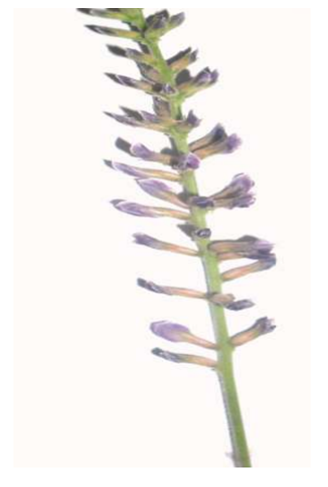 | Figure 7. Sequential arrangement of the flower of the licorice plant |
2. Material and Methods
M.Yu. Ibragimov studied the bioecological characteristics of the sweet clover plant, according to which the sweet clover plant is resistant to soil salinization, grows in less saline areas with groundwater depths of 1-1.5 meters, has a well-developed root system, grows to the deepest layers of the soil, and can utilize groundwater [7].
3. Results and Discussion
In a study conducted in an experimental plot where licorice grew naturally with sufficient moisture and a loamy soil composition, we studied the length of the plant's stem and the formation of its generative organs (Table 1).Table 1. Stem length and formation of the generative organs of the licorice plant
 |
| |
|
According to the table above, it grows and thrives well along canals and ditches, on dams along the edges of crop fields, and in floodplain irrigation areas. The average length of the stem of the licorice plant studied in these areas is 157 cm, where 14 generative branches have developed, an average of 590 flowers have formed, 272 of which form pods. The pods formed on well-developed roots of the licorice plant are bare, flat, straight, and multi-seeded. Length 1-2.5 cm, average width 0.5 cm. The seeds are kidney-shaped, dark, light brown or light blue, 2.0-2.6 mm long and 1-2 mm wide. Fully developed seeds are found on some pods. The seed productivity of the licorice has been studied by some scientists.In the conditions of Azerbaijan, there are an average of 85 pods and 340 seeds on one plant of the natural licorice. A sweet clover plant growing along the Ili River had an average of 50 pods on one stem [6]. In the meadows of the lower part of the Amu Darya, the number of pods per plant ranges from 2 to 108 pieces, and the number of seeds from 8 to 442.A. Baxiyev (1976) indicates that the number of spikelets in 8 plant communities growing mixed with licorice in the lower parts of the Amu Darya River averages 31-221 and 33-189 on lateral branches.The seed productivity of the observed plants in the experimental plot was studied. In this case, the total number of pods on one plant, the number of seeds on one pod, the number of seeds on the plant, and the absolute weight of the seeds were determined. Based on this data, the seed productivity of one plant was studied.According to observations, the average number of pods per plant is 272, and the number of seeds per pod is 5. The absolute weight of the seeds (1000 pieces) is 7.913 grams. The plant's seed yield is 10.762 grams. (Table 2) Table 2. Seed yield of licorice
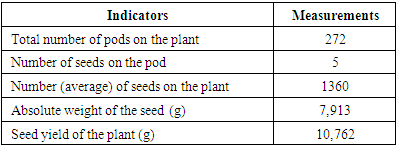 |
| |
|
The growth and formation of both the underground and above-ground parts of the licorice plant, the productivity of root raw material, the height of the above-ground portion (i.e., the plant's stature), the number of lateral branches, and the development of reproductive organs formed in the plant are dependent on the climatic and soil conditions of the environment in which the plant grows. The plant's underground part consists of a vertically growing root and horizontally growing root stocks. | Figure 8. The root system of the licorice plant. Formation of underground branches and horizontal roots |
Root system. The root system of the licorice plant, its morphological and anatomical structure, has been studied by several scientists [2,3,4]. When its seeds are sown in the soil, they germinate under favorable conditions, forming a root from the initial seed. It then grows and reaches the deeper layers of the soil (Figure 8).This root is also called the maternal root. The head of the female root is a collection of seven-lobed nodular buds, from which the above-ground branches and rhizomes grow. The root of the main root (lateral and adventitious) does not have a renewal bud.Root stems have easily visible axillary buds, arranged in a spiral 3-8 cm thick. In the second year, the root bud acquires the characteristics of an underground stem. In the third year, it is covered with thick, grayish shells. Hard tissues develop vigorously in the lateral and adventitious roots, as well as in the rhizome.Some researchers indicate that the licorice plant propagates through root vegetation. A. Baxiyev (1976) in his research in the lower part of the Amu Darya River emphasizes that vegetative propagation occurs through root vegetation [1]. Root cuttings 20-30 cm long develop near the root collar from the excavated and studied plant roots.When grown from seeds, the two-year-old root reaches a length of 40-120 cm and a diameter of 1.5 cm, while the stem grows to 30-80 cm. During this period, lateral roots appear on the main root. This plant develops horizontal rootlets up to 1 meter long, with a diameter of 1.5 cm. They grow 10-15 cm below the soil surface. In mature (5-7-year-old) plants, the rootlets are located in a layer 15-40 cm deep.The horizontal root thickens up to 3 cm in length and grows up to 5 m. In the lower parts of the Amu Darya, the diameter of the main root of the licorice plant is 5-12 cm and it grows up to 1-1.5 meters (Nadejdina). According to A. Baxiyev (1976), the main root of this plant has a diameter of 3-15 cm and grows to a depth of 1 to 2 meters. Its mature 5-6-year-old roots and rhizomes are dug up and harvested in autumn or spring [2].This licorice plant is one of the most important plants for the national economy. It is the only wild plant in Karakalpakstan whose raw material is exported [1]. The medicinal properties of this plant are mentioned in the work of Abu Ali Ibn Sina and Abu Rayhan al-Biruni (Kitab as-Saydana). The Tibetan peoples claim that its roots influence the population's longevity and significant growth. The root of licorice contains up to 23% glycerin, which upon hydrolysis forms glyceric acid and its molecular form - glucuronic acid. It also contains flavonoids, essential oils (0.03%), ascorbic acid (11-30mg%), sugar, yellow pigment, etc. (Davletmuratov, Uteniyazov, 1999). According to other sources (from the internet), its roots mainly contain: glycyrrhizic acid and its potassium and calcium salts, 27 different flavonoids, sugar (glucose) up to 20% 3% sour substance, 20% starch, essential oil, dyes, vitamins, tannins, sticky substances, organic acids (mainly malic acid), protein, asparagenes, etc.The stem contains 11-18% protein, 10-15% proteins, 3.3-9.1% fat, and other beneficial compounds. The bark of the underground part consists of liver-colored roots and rhizomes, reaching a length of approximately 180-200 cm. The amount of glycyrrhizic acid in roots and rhizomes is 3-24%, glucose-8%, sucrose-11%, starch-34%, and fiber-24%. The amount of substances subject to water extraction reaches 43%.
4. Conclusions
Due to its strong nectar release, it attracts bees and other insects. The above-ground part of the licorice is used as nutritious food for animals. Currently, the export of licorice root to foreign countries has been established in Karakalpakstan.Thus, when cultivating licorice, which is considered a valuable raw material, it is advisable to propagate it in three main ways: by seeds, rhizomes, and by growing seedlings.
References
| [1] | Baxiyev A., Qaniyazov S.K. Methodological Guidelines for Improving Natural Sweet Trees and Their Cultivation in the Lower Reaches of the Amu Darya. Nukus "Karakalpakstan" 2003. |
| [2] | Baxhiev A.B. Phytocoenotic and ecological features of the licorice formation in Karakalpakstan. Natural resources of the lower Amu Darya. Tashkent. "Fan" 1974. p. 239-243. |
| [3] | Gladysheva A.I. Bio-ecological features of licorice root in connection with the introduction of its culture in the Amu Darya basin. Abstract of PhD dissertation. Ashgabat, 1967 22 p. |
| [4] | Korovin O.N., Bakhiyev A.B., Tadjitdinov M.T., Sarybayev B.Sh. Illustrated Determiner of Higher Plants of Karakalpakstan and Khorezm // Tashkent, FAS. -1982.-23p. |
| [5] | Kerbabayev B.B., Gladysheva A.B., Keljayeva P.Sh., Gekshova T.M. Licorice Culture in Turkmenistan (systematics, bioecology, introduction to culture). Ashgabat, Ilim, 1989. 192 p. |
| [6] | Kerbabayev B.B., Gladysheva A.I., Keljayeva P.Sh. Ways to Improve natural licorice phytocenoses and introduction of licorice into the culture. Ashgabat Turkmen. NIINTI 1986. 39 p. |
| [7] | Ibragimov M.Yu., Gaipov M.Kh., Zakimov A.M. Agrotechnology of Sowing and Growing Licorice in the Territories of the Republic of Karakalpakstan. Nukus, "Karakalpakstan," 2019. |










 Abstract
Abstract Reference
Reference Full-Text PDF
Full-Text PDF Full-text HTML
Full-text HTML
